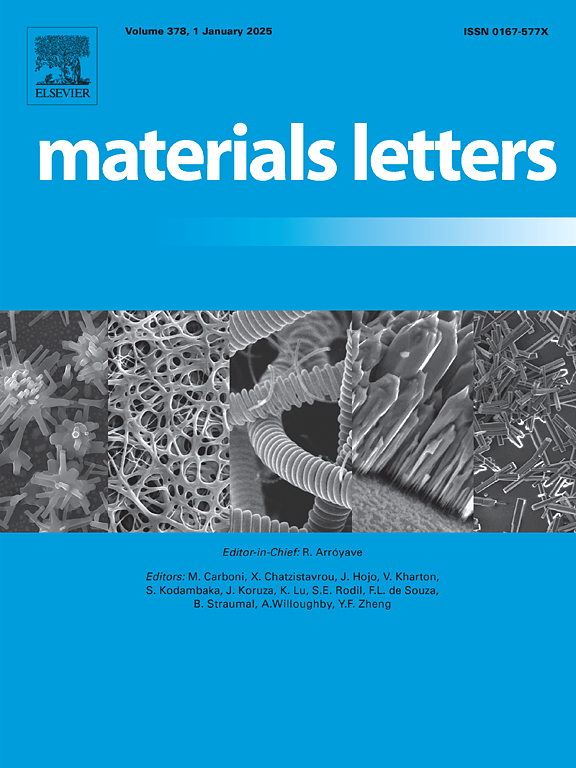(Co,CoO)/N-TiO2 as a highly efficient catalyst for oxygen reduction reaction with excellent zinc-air battery performance
IF 2.7
4区 材料科学
Q3 MATERIALS SCIENCE, MULTIDISCIPLINARY
引用次数: 0
Abstract
The development of highly efficient and low-cost non-precious metal oxygen reduction catalysts holds critical significance for advancing the commercialization of metal-air battery and fuel cell. In this work, we perform N-doping and Co-loading on TiO2 to enhance its ORR performance. The (Co,CoO)55/N-TiO2 catalyst (prepared with 55 mg of Co(CH3COO)2·4H2O) exhibits a half-wave potential (0.865 V versus RHE) comparable to commercial Pt/C, along with significantly enhanced electrocatalytic kinetics. Moreover, when employed in Zinc-air battery, the (Co,CoO)55/N-TiO2 catalyst demonstrates superior performance compared to commercial Pt/C. This performance enhancement originates from the synergistic interplay between Co species and the N-TiO2 matrix, where N-doping facilitates the formation of both Co–N coordination structures and O–Ti–N bonds. These structural configurations can significantly improve oxygen reduction activity.
(Co,CoO)/N-TiO2作为氧还原反应的高效催化剂,具有优异的锌-空气电池性能
开发高效、低成本的非贵金属氧还原催化剂对推进金属空气电池和燃料电池的商业化具有重要意义。在这项工作中,我们对TiO2进行n掺杂和共负载以提高其ORR性能。(Co,CoO)55/N-TiO2催化剂(以55 mg Co(CH3COO)2·4H2O制备)具有与商用Pt/C相当的半波电位(相对于RHE为0.865 V),并且电催化动力学显著增强。此外,在锌空气电池中,(Co,CoO)55/N-TiO2催化剂表现出比商用Pt/C更优越的性能。这种性能的增强源于Co物种与N-TiO2基体之间的协同作用,其中n掺杂促进了Co - n配位结构和O-Ti-N键的形成。这些结构构型可以显著提高氧还原活性。
本文章由计算机程序翻译,如有差异,请以英文原文为准。
求助全文
约1分钟内获得全文
求助全文
来源期刊

Materials Letters
工程技术-材料科学:综合
CiteScore
5.60
自引率
3.30%
发文量
1948
审稿时长
50 days
期刊介绍:
Materials Letters has an open access mirror journal Materials Letters: X, sharing the same aims and scope, editorial team, submission system and rigorous peer review.
Materials Letters is dedicated to publishing novel, cutting edge reports of broad interest to the materials community. The journal provides a forum for materials scientists and engineers, physicists, and chemists to rapidly communicate on the most important topics in the field of materials.
Contributions include, but are not limited to, a variety of topics such as:
• Materials - Metals and alloys, amorphous solids, ceramics, composites, polymers, semiconductors
• Applications - Structural, opto-electronic, magnetic, medical, MEMS, sensors, smart
• Characterization - Analytical, microscopy, scanning probes, nanoscopic, optical, electrical, magnetic, acoustic, spectroscopic, diffraction
• Novel Materials - Micro and nanostructures (nanowires, nanotubes, nanoparticles), nanocomposites, thin films, superlattices, quantum dots.
• Processing - Crystal growth, thin film processing, sol-gel processing, mechanical processing, assembly, nanocrystalline processing.
• Properties - Mechanical, magnetic, optical, electrical, ferroelectric, thermal, interfacial, transport, thermodynamic
• Synthesis - Quenching, solid state, solidification, solution synthesis, vapor deposition, high pressure, explosive
 求助内容:
求助内容: 应助结果提醒方式:
应助结果提醒方式:


